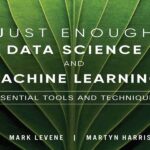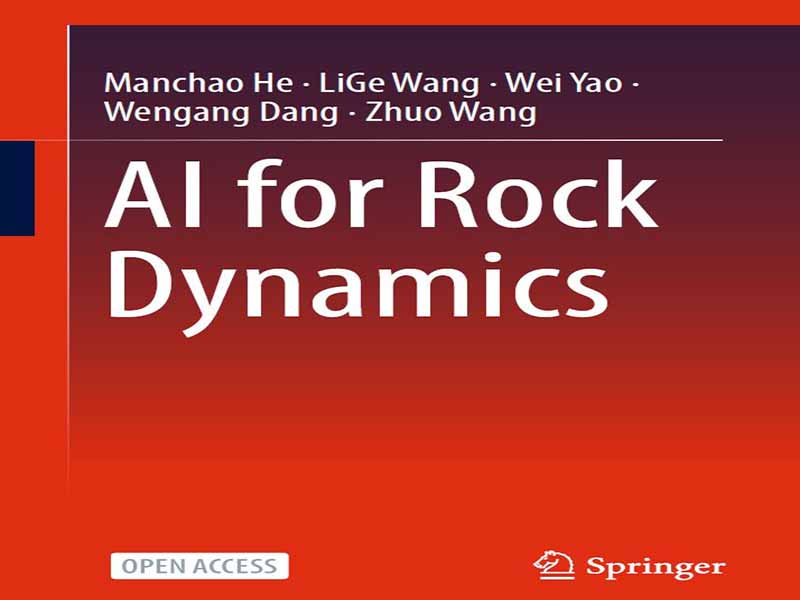- عنوان کتاب: AI for Rock Dynamics with Foundation Models
- نویسنده: Manchao He, LiGe Wang, Wei Yao, Wengang Dang
- حوزه: کاربرد هوش مصنوعی
- سال انتشار: 2025
- تعداد صفحه: 527
- زبان اصلی: انگلیسی
- نوع فایل: pdf
- حجم فایل: 8.33 مگابایت
همانطور که در آستانه انقلاب هوش مصنوعی در سال ۲۰۲۴ ایستادهایم، آشکار است که ادغام هوش مصنوعی در تحقیقات علمی شتاب قابل توجهی گرفته است. محققان در رشتههای مختلف از قدرت هوش مصنوعی برای سادهسازی گردش کار خود، کشف بینشهای جدید و تسریع سرعت اکتشافات علمی استفاده میکنند. از خودکارسازی وظایف خستهکننده تجزیه و تحلیل دادهها گرفته تا تولید فرضیهها و کمک به فرآیند نوشتن، هوش مصنوعی به ابزاری ضروری در زرادخانه محققان مدرن تبدیل شده است. در همین زمینه است که ما شروع به نوشتن این کتاب، هوش مصنوعی برای دینامیک سنگ، میکنیم. انگیزه ما از این شناخت ناشی میشود که هوش مصنوعی پتانسیل تغییر نحوه ترکیب و ارائه دانش علمی ما را دارد، در حالی که پیچیدگی و دقت مورد نیاز در نگارش دانشگاهی را تصدیق میکنیم. با این حال، تشخیص محدودیتهای LLMها نیز به همان اندازه مهم است. سفر ما در خلق این کتاب، هم پتانسیل و هم محدودیتهای هوش مصنوعی را در نگارش دانشگاهی آشکار کرده است. در حالی که LLMها در پردازش حجم زیادی از اطلاعات و مدیریت استدلال غیرقطعی برتری دارند، با محدودیتهای قابل توجهی نیز روبرو هستند. این محدودیتها شامل وابستگی آنها به دادههای آموزشی و چالشها در درک نکات ظریف خاص حوزه است. دقیقاً همین محدودیتها بود که ما را بر آن داشت تا در طول نگارش این کتاب، مرزهای تعامل بین هوش مصنوعی و تخصص انسانی را به طور مداوم بررسی کنیم. ما تیمی متشکل از بیش از 20 متخصص از زیرشاخههای مختلف دینامیک سنگ را برای همکاری با سیستم هوش مصنوعی گرد هم آوردیم تا محتوای تولید شده توسط هوش مصنوعی را با دقت بررسی، اعتبارسنجی و اصلاح کنیم. این فرآیند، نقش حیاتی هوش انسانی را در هدایت و بهینهسازی خروجی هوش مصنوعی برجسته کرد. با این حال، باید اذعان کنیم که علیرغم تلاشهای فراوان ما، محتوای این کتاب ممکن است هنوز حاوی برخی تناقضات یا نادرستیها باشد. این امر، محدودیتهای فعلی فناوری هوش مصنوعی، به ویژه LLMها، را در هنگام مواجهه با دانش تخصصی حوزه، بیشتر برجسته میکند. امیدواریم از طریق این کتاب، به گفتگوی جاری در مورد نقش هوش مصنوعی در انتشارات دانشگاهی کمک کنیم و یک مطالعه موردی از کاربرد آن در زمینه دینامیک سنگ ارائه دهیم. ما معتقدیم که این کاوش نه تنها مزایا و چالشهای بالقوه نگارش با کمک هوش مصنوعی را روشن میکند، بلکه سایر محققان را نیز ترغیب میکند تا در نظر بگیرند که چگونه میتوانند از این فناوریها در کار خود استفاده کنند. خلق هوش مصنوعی برای دینامیک سنگ، یک تجربه متحولکننده برای کل تیم نویسنده بوده است. این تلاش مشترک نه تنها درک ما از این حوزه را عمیقتر کرده، بلکه چشمان ما را به پتانسیل عظیم همکاری بین رشتهای و تحقیقات مبتنی بر هوش مصنوعی باز کرده است. موفقیت این پروژه جرقهای از هیجان و امکان را برای آینده تحقیقات دینامیک سنگ روشن کرده است. ادغام فناوریهای هوش مصنوعی در فرآیند تحقیق، پتانسیل عظیمی برای تسریع سرعت کشف، مدیریت حجم زیادی از دادهها و تسهیل اشتراکگذاری کارآمدتر دانش دارد. همانطور که به جلو حرکت میکنیم، بسیار مهم است که با نگاهی تیزبین به این تحولات نزدیک شویم و اطمینان حاصل کنیم که هوش مصنوعی به جای جایگزینی، در خدمت تقویت تخصص انسانی است. من به عنوان یک محقق، کاملاً از اهمیت و قدرت دگرگونکننده علم باز آگاه هستم. فرآیند خلاقانه این کتاب، خود، یک تمرین زنده از مفهوم علم باز است. ما اشتراکگذاری گسترده دانش، همکاری بین رشتهای و تعامل هماهنگ بین ذینفعان مختلف را تجربه کردهایم. اگرچه این کتاب بر دینامیک سنگ تمرکز دارد، اما شیوههای علم باز برای کل جامعه دانشگاهی اهمیت آموزندهای دارند. من قاطعانه معتقدم که حفظ ارزشهای اساسی باز بودن، شفافیت و همکاری، اهمیت گستردهای برای توسعه علم دارد. با نگاه به آینده، ما این کتاب را به عنوان کاتالیزوری برای نوآوری و همکاری بیشتر در حوزه دینامیک سنگ و فراتر از آن پیشبینی میکنیم. با نمایش قدرت همکاری بین رشتهای و تحقیقات مبتنی بر هوش مصنوعی، امیدواریم محققان، متخصصان و دانشجویان را برای پذیرش این مرزهای جدید و گسترش مرزهای ممکن، الهام بخشیم. در پایان، سفر ایجاد هوش مصنوعی برای دینامیک سنگ، تجربهای دگرگونکننده برای تیم نویسنده بوده است که درسهای ارزشمندی در مورد قدرت همکاری و پتانسیل تحقیقات مبتنی بر هوش مصنوعی ارائه میدهد. همانطور که به آینده نگاه میکنیم، سرشار از خوشبینی و هیجان برای تکامل مداوم تحقیقات دینامیک سنگ هستیم. صمیمانه امیدواریم که این کتاب به عنوان منبع الهام و دانش برای همه کسانی که به دنبال مشارکت در این حوزه پویا و اساسی هستند، عمل کند. در پایان این مقدمه، میخواهیم عمیقترین قدردانی خود را از همه کسانی که از ایجاد «پیشرفتهای تحقیقاتی اخیر دینامیک سنگ» حمایت و در آن مشارکت داشتهاند، ابراز کنیم. اول و مهمتر از همه، از انجمن علم و فناوری چین (CAST) به خاطر تلاشهای بیدریغشان قدردانی میکنیم.
As we stand at the precipice of an AI revolution in 2024, it is manifest that the integration of AI in scientific research has gained significant momentum. Researchers across diverse disciplines are leveraging the power of AI to streamline their workflows, uncover novel insights, and accelerate the pace of scientific discovery. From automating tedious data analysis tasks to generating hypotheses and aiding in the writing process, AI has become an indispensable tool in the modern researcher’s arsenal. It is in this context that we embark on the creation of this book, AI for Rock Dynamics. Our motivation stems from the recognition that AI has the potential to transform how we synthesize and present scientific knowledge, while acknowledging the complexity and rigor required in academic writing. However, it is equally important to recognize the limitations of LLMs. Our journey in creating this book has revealed both the potential and limitations of AI in academic writing. While LLMs excel at processing vast amounts of information and handling non-deterministic reasoning, they also face significant constraints. These limitations include their dependence on training data and challenges in grasping domain-specific nuances. It is precisely these limitations that drove us to continuously explore the boundaries of interaction between artificial intelligence and human expertise during the creation of this book. We assembled a team of over 20 experts from various subfields of rock dynamics to collaborate with the AI system, carefully reviewing, validating, and refining the AI-generated content. This process highlighted the crucial role of human intelligence in guiding and optimizing the AI output. However, we must also acknowledge that despite our best efforts, the content of this book may still contain some inconsistencies or inaccuracies. This further underscores the current limitations of AI technology, particularly LLMs, when dealing with specialized domain knowledge. Through this book, we hope to contribute to the ongoing conversation about the role of AI in academic publishing and to provide a case study of its application in the field of rock dynamics. We believe that this exploration will not only shed light on the potential benefits and challenges of AI-assisted writing but also inspire other researchers to consider how they might leverage these technologies in their own work. The creation of AI for Rock Dynamics has been a transformative experience for the entire author team. This collaborative endeavor has not only deepened our understanding of the field but also opened our eyes to the immense potential of interdisciplinary cooperation and AI-assisted research. The success of this project has ignited a spark of excitement and possibility for the future of rock dynamics research. The integration of AI technologies into the research process holds immense potential for accelerating the pace of discovery, handling large volumes of data, and facilitating more efficient knowledge sharing. As we move forward, it is crucial to approach these developments with a discerning eye, ensuring that AI serves to augment, rather than replace, human expertise. As a researcher, I am fully aware of the importance and transformative power of open science. The creative process of this book itself is a vivid practice of the concept of open science. We have experienced extensive knowledge sharing, interdisciplinary collaboration, and harmonious interaction among different stakeholders. Although this book focuses on rock dynamics, the open science practices have enlightening significance for the entire academic community. I firmly believe that upholding the basic values of openness, transparency, and collaboration, has far-reaching significance for the development of science. Looking ahead, we envision this book as a catalyst for further innovation and collaboration within the field of rock dynamics and beyond. By showcasing the power of interdisciplinary collaboration and AI-assisted research, we hope to inspire researchers, practitioners, and students to embrace these new frontiers and push the boundaries of what is possible. In conclusion, the journey of creating AI for Rock Dynamics has been a transformative experience for the author team, offering valuable lessons on the power of collaboration and the potential of AI-assisted research. As we look to the future, we are filled with optimism and excitement for the continued evolution of rock dynamics research. It is our sincere hope that this book will serve as a source of inspiration and knowledge for all those who seek to contribute to this dynamic and essential field. As we conclude this preface, we would like to express our deepest gratitude to all those who have supported and contributed to the creation of “Recent Research Progress of Rock Dynamics.” First and foremost, we extend our appreciation to the China Association for Science and Technology (CAST) for their unwavering support and guidance. Their commitment to advancing scientific research and promoting technological innovation has been instrumental in bringing this project to fruition. We also extend our gratitude to the China National Publications Import and Export (Group) Corporation (CNPIEC) for their unwavering support and belief in the potential of this project. Your commitment to advancing scientific knowledge and fostering international cooperation has been truly remarkable. As the parent company of Kexin, they have demonstrated remarkable foresight in embracing technological innovation in scientific publishing.
این کتاب را میتوانید از لینک زیر بصورت رایگان دانلود کنید:
Download: AI for Rock Dynamics



































نظرات کاربران